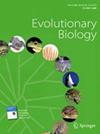Shape and Size Variation in Elapid Snake Fangs and the Effects of Phylogeny and Diet
IF 1.9
2区 生物学
Q3 EVOLUTIONARY BIOLOGY
引用次数: 0
Abstract
Abstract Recent studies have found correlations between the shape of snake teeth/fangs and diet. These studies were done at a very broad phylogenetic scale, making it desirable to test if correlations are still detectable at a narrower evolutionary scale, specifically within the family Elapidae. To this end, we studied fang shape in a dense selection of elapids representing most genera worldwide (74%). We used three-dimensional geometric morphometrics to analyse fang diversity and evaluate possible correlations between fang shape, fang size, and diet. We detected weak phylogenetic signal for both shape and absolute fang size, and found that evolutionary allometry contributes a small proportion of the among-species variation. The distribution of elapid fangs in morphospace was found to be surprisingly conservative, with only a few outliers. The only three dietary categories that were found to have a significant effect on fang shape are mammals, lizards, and reptile eggs, with mammals having a significant effect also on absolute but not relative fang size. Our results show that there are disparate patterns in fang-diet relationships at different evolutionary scales. Across all venomous snakes, previous work found that fangs are strongly influenced by diet, but within elapids our study shows these same associations are weaker and often non-significant. This could result from limitations in these types of studies, or could reflect the fact that elapids are a relatively young clade, where recent extensive divergences in diet have yet to be mirrored in fang shape, suggesting a lag between changes in ecology and dental morphology.

舌蛇毒牙形状和大小的变异及其系统发育和食性的影响
最近的研究发现了蛇的牙齿/尖牙的形状与饮食之间的相关性。这些研究是在一个非常广泛的系统发育尺度上进行的,因此有必要测试在一个更窄的进化尺度上是否仍然可以检测到相关性,特别是在Elapidae家族中。为此,我们选择了世界上大多数属(74%)的小圆蚧,对它们的齿形进行了密集的研究。我们使用三维几何形态计量学分析了牙齿多样性,并评估了牙齿形状、大小和饮食之间可能的相关性。我们检测到牙齿形状和绝对大小的微弱系统发育信号,并发现进化异速在种间变异中只占很小的比例。快速尖牙在形态空间上的分布令人惊讶地保守,只有几个异常值。只有三种饮食对牙齿形状有显著影响:哺乳动物、蜥蜴和爬行动物的卵,哺乳动物对牙齿的绝对大小也有显著影响,但对相对大小没有显著影响。我们的研究结果表明,在不同的进化尺度上,牙齿与饮食的关系存在不同的模式。之前的研究发现,在所有毒蛇中,毒牙都受到饮食的强烈影响,但在鱿鱼中,我们的研究表明,这些联系较弱,而且往往不显著。这可能是由于这些类型的研究的局限性,或者可能反映了一个事实,即蝶类是一个相对年轻的分支,最近在饮食上的广泛分歧尚未反映在牙齿形状上,这表明生态和牙齿形态的变化之间存在滞后。
本文章由计算机程序翻译,如有差异,请以英文原文为准。
求助全文
约1分钟内获得全文
求助全文
来源期刊

Evolutionary Biology
生物-进化生物学
CiteScore
3.80
自引率
4.00%
发文量
25
审稿时长
>12 weeks
期刊介绍:
The aim, scope, and format of Evolutionary Biology will be based on the following principles:
Evolutionary Biology will publish original articles and reviews that address issues and subjects of core concern in evolutionary biology. All papers must make original contributions to our understanding of the evolutionary process.
The journal will remain true to the original intent of the original series to provide a place for broad syntheses in evolutionary biology. Articles will contribute to this goal by defining the direction of current and future research and by building conceptual links between disciplines. In articles presenting an empirical analysis, the results of these analyses must be integrated within a broader evolutionary framework.
Authors are encouraged to submit papers presenting novel conceptual frameworks or major challenges to accepted ideas.
While brevity is encouraged, there is no formal restriction on length for major articles.
The journal aims to keep the time between original submission and appearance online to within four months and will encourage authors to revise rapidly once a paper has been submitted and deemed acceptable.
 求助内容:
求助内容: 应助结果提醒方式:
应助结果提醒方式:


